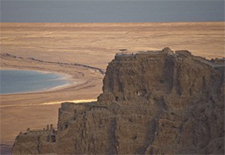The Anti-Mountaintop Experience
The trail jackknifed its way up the mountain like it was sponsored by Target. (up & up? Anyone?) I continued my ascent, jumping over rocks and skirting boulders. I had three primary goals as I ran: 1) not to crash into any of the cacti lining the path, 2) not to fall off the mountain, and 3) not to crash into any of the cacti in the process of falling off the mountain.
As I may have suggested last week, there’s something about running in the desert that makes me feel like I’m going to die. Think of every desert movie you’ve ever seen. Nothing good happens in the desert. You never hear the line, “And they lived happily ever after in the desert.” No, people go to the desert to die.
Anyway.
The mountain in question was Pinnacle Peak, elevation 2,889 feet. Zigzagging upward, I hurdled the occasional railroad tie embedded for the purpose of erosion control and slowed to a walk around the not-so-occasional hairpin turn. Up. Up. Hurdle. Walk. Up. Up. Hurdle. Walk. Cactus! Up. Up. And then, I arrived.
PINNACLE PEAK SUMMIT
The sign marked the highest point of the trail. I climbed atop a giant boulder at the furthest jut of the lookout point and gazed over the sprawling desert valley below. Breaking the muted monotony of sand and rock were incongruous lush oases—a meandering, Kelly green golf course bordered by grandiose homes, the kind described by Robin Leach on Lifestyles of the Rich and Famous; resorts with icy blue pools; manmade lakes skirted by transplanted greenery. It was lavish and indulgent and… really, really far away.
 For all the chatter about a “mountaintop experience,” few people ever mention that sometimes the top of a mountain is, well, lonely. Desolate. Arid. Uncomfortable. Sometimes, it’s the exact opposite of a mountaintop experience.
For all the chatter about a “mountaintop experience,” few people ever mention that sometimes the top of a mountain is, well, lonely. Desolate. Arid. Uncomfortable. Sometimes, it’s the exact opposite of a mountaintop experience.
The top of the mountain was faded brown and bleached tan. Even the rocks looked dehydrated. There were no trees. There was no shade. The only signs of life were short, squatty, and covered in needles and spikes. It was hot. And quiet.
But this was the mountain I had chosen to climb.
For some reason, as I stood on the boulder, alone on a scorched and barren mountain, tired, thirsty, looking down on the lavish population below, I was struck by a very real picture of what it means to stand for your beliefs.
I imagine every generation has considered itself a paradigm shift in the scheme of human history, but the conflicts and controversies fracturing our nation currently seem to carry especial significance. The solemn and sweeping consequence of each issue is rivaled only by the scope of the issues themselves. Our moral anatomy is being drawn and quartered. Tragedies aren’t discussed; they are exploited. Reason is exchanged for vitriol, empathy for hostility, discussion for slander, and justice for propaganda.
Geez. Talk about a Jimmy Carter “Crisis of Confidence” speech, amiright?
Earlier that week, I had had somewhat of a meltdown in the car. It came completely out of left field. (My meltdown, that is, not the car.) Tom was the unfortunate witness of my emotional outburst, and he drove quietly as I first brought up a particular topic, which led to my opinion on the topic, which led to hypothetical argument, which led to tears, which led to the spewing of every point and counterpoint, which led to more tears, which led to a concluding flourish: “WHAT THE HECK IS WRONG WITH PEOPLE?”
Bottled up frustration, anyone?
It’s difficult when you believe strongly about a fundamental moral issue and you are (or, at least, feel like you are) in the minority. Yes, you will continue to stand for what you know is right, but sometimes it can be lonely. Fatiguing. Uncomfortable.
Sometimes, it can be like standing on a mountaintop in the middle of the desert.
This is what I thought about as I stood on the boulder overlooking the more hospitable terrain below. I stood there for quite a while before I finally turned around and hopped back down onto the gravel trail. To my surprise, I was greeted by two fellow runners, water bottles in hand.
“Great view, huh?” one of them said, smiling.
“Yeah,” I said as I stepped aside for them to take their turn atop the boulder, “it really is beautiful.”
I wasn’t alone after all.
As long as there is truth and falsehood, as long as there is right and wrong, as long as there is justice and injustice, there will be conflict. We must take inventory of our beliefs and know where we stand.

Amy L. Marxkors is the author of The Lola Papers: Marathons, Misadventures, and How I Became a Serious Runner and Powered By Hope: The Teri Griege Story. Click here to receive Amy's weekly article via email.
Connect With Us
see the latest from Fleet Feet St. Louis